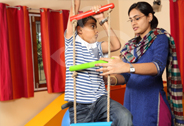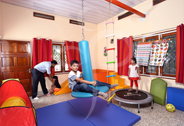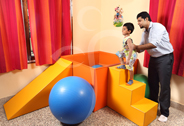Sensory Integration Therapy
What is Sensory Integration

Our body and the environment send information to our brain through senses (touch, movement, smell, taste, sight, hearing & balance). Our brains are programmed to organize the incoming sensory information to make it meaningful to us. For example, imagine yourself stepping into a bus. As you place your feet on the first step, the bus starts moving. Automatically you adjust your body to keep yourself balanced, slowly step ahead and find a place to sit. This is SENSORY INTEGRATION. If we have good sensory integration, processing and organizing information happens automatically and we react promptly and efficiently to a sensory input.
Sensory integration (SI) is the process of receiving, organizing, and interpreting the sensory input, which becomes the basis for motor planning, learning and behavior. When this process is disorganized, it is called Sensory Integration Dysfunction.
Sensory Integration Therapy

Sensory Integration Therapy is a fun & play based intervention which helps in dealing with sensory problems. Children who have problems modulating sensory input may experience hypersensitivity, hyposensitivity or both to an impairing degree which may make them dysfunctional at school, at home and world at large. With Sensory Integration Therapy, the therapist addresses the sensory issues and helps a child to produce normal responses to sensory stimuli.
Sensory Integration Therapy involves various techniques stimulating vestibular, proprioceptive, tactile, auditory, visual, oral and olfactory senses.
Vestibular Movement (sense of balance & weight)Children NEED to move! For some it is difficult due to fears, for others they just cannot seem to get enough. Depending upon the child's interests and enthusiasm, therapist involves the child in various activities which help in normalizing the child's movement experiences.
Activities included in therapy which assists in regulating movement experiences are
- T- DISC
- FLAT SWING
- SCOOTER BOARD
Proprioceptive Activities

Proprioception refers to motor control and planning, body awareness, grading of movement (knowing how "hard" or "soft" to perform a task), and postural stability.
Children with proprioceptive problems will have difficulty with both gross and fine motor tasks such as riding a bike, writing, walking, crawling, or playing sports whereas some other children require additional proprioceptive input just to keep their bodies calm, organized, and to regulate arousal levels. Therapists utilize various activities, which are almost endless in choices, to regulate the functions of proprioceptors.
Heavy Work Activities
These types of activities are imperative for children who are the crashers, the ones that cannot ever seem to sit still. They have difficulty regulating their arousal levels. Regular heavy input into their neurological systems will help them calm down. Often these activities include jumping with or without weights, bouncing, rocking, pushing, pulling, swinging and being "squished". Though all kids need such activities, children with under-reactive neurological systems will need it even more. These activities are truly used for most sensory processing issues and can have an amazing affect on the nervous system for regulation and modulation.
Play Tunnels & Tents

The tunnel acts as an active gross motor and bilateral motor coordination activity just by having the child crawl through them. It creates a tactile experience by placing different textured objects or carpet squares inside the tunnel. Shaking the tunnel up (as in an earthquake), while the children are in, helps to get increased proprioceptive input and vestibular reactions.
Sand Play
Playing in the sand provides essential yet fun-filled ways to experience necessary tactile input for a tactile seeking child. It helps in improving creativity. Filling the tables with sand, rice, shaving cream, water, or any textured substance will help to encourage exploration too.
Clay Activities
Children need and love to play dough, unless they have tactile defensiveness. There are so many types of play dough, scented to unscented, textured to non-textured. It also helps in improving fine motor co-ordination.
Occupational therapy thus plays an important role in improving the functional abilities of children and promotes independence in their day-to-day activities.
